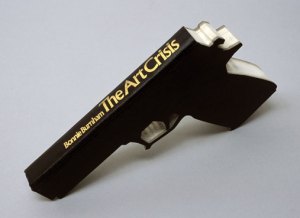Are Art Auction Houses Mocking Art Buyers? – artmarketblog.com
 A couple of posts ago I said that I have great respect for art auction houses – well, after the events of the last few weeks that respect is rapidly declining. If you have read my last few posts on contemporary art auctions then you will know that I have issues with the way some auction houses conduct their business. Unfortunately, over the last few days it has come to my attention that the problems that I identified are only the tip of the iceberg. Not only does there seem to be the potential for art auction buyers to be influenced by incorrectly categorised and catalogued works, but apparently some auction houses now appear to conducting auctions in a manner that suggests that art buyers are unable to make decisions for themselves when buying at auction, and need to be told what they should be buying. There are two recent events that have lead me to this opinion the first being the Phillips De Pury “Carte Blanche” auction, and the second being the recent Sotheby’s November contemporary art auction. Before I begin I want to state that the following is purely my opinion and not in any way a statement of fact.
A couple of posts ago I said that I have great respect for art auction houses – well, after the events of the last few weeks that respect is rapidly declining. If you have read my last few posts on contemporary art auctions then you will know that I have issues with the way some auction houses conduct their business. Unfortunately, over the last few days it has come to my attention that the problems that I identified are only the tip of the iceberg. Not only does there seem to be the potential for art auction buyers to be influenced by incorrectly categorised and catalogued works, but apparently some auction houses now appear to conducting auctions in a manner that suggests that art buyers are unable to make decisions for themselves when buying at auction, and need to be told what they should be buying. There are two recent events that have lead me to this opinion the first being the Phillips De Pury “Carte Blanche” auction, and the second being the recent Sotheby’s November contemporary art auction. Before I begin I want to state that the following is purely my opinion and not in any way a statement of fact.
A comment by Alex Rotter, head of the Contemporary Art Department at Sotheby’s in New York, was the first indication I received that the extent to which auction houses are influencing what buyers purchase may have increased recently. Yes, auction houses have been influencing what art buyers purchase for many years, and as businesses are more than entitled to do so, but it seems that they have begun to exert an even stronger influence of late with the seemingly blatant tactics that have caused me to write this post. According to Rotter, commenting on the Sotheby’s November contemporary art auction, “The success of tonight’s sale was the result of editing – getting the right young, Pop and Abstract Expressionist material into the sale”. So, is this an indication that auction houses are doing something that I am sure many suspect they have been doing for some time – deliberately orchestrating sales to encourage potential buyers to pay more for works than they should, or purchase works that they didn’t originally intend to buy? Is Rotter suggesting that by including a certain array of works, and arranging the catalogue in a particular way, that the auction houses are able to influence buying behaviour? Or, is he suggesting that the contemporary art sales are so carefully planned to ensure that the auction consists of works that they know they have buyers for, that they auction house can guarantee themselves a successful sale before the sale has taken place? Or is the meaning of this comment something else entirely? I will leave the answers to these questions up to you for the mean time. Food for thought though……
Now for the “Carte Blanche” sale. Having a themed auction that allows buyers who are looking for something very specific to be offered a range of related objects is something that I have no problem with; Phillips often hold themed sales such as their music themed sales. I do, however, have issues with a blatant marketing tactic being masked as a cultural and curatorial exercise, which appears to be what has taken place with the Phillips De Pury “Carte Blanche” sale. Philippe Segalot, the so called “curator” of the sale, is quoted as saying in a Phillips De Pury press release that:
“I have always been interested in the concept of curated sales, where the artworks are selected not for their market value but for their artistic quality, historical importance and coherence within the group. Here, I tried to push this idea further by bringing together a small “collection” comprised of my favourite works by my favorite artists. The result is a true self-portrait, a close representation of my life as an art lover, an art collector and an art advisor.”
To begin with, I have a problem with the notion that such a wide range of Segalot’s favourite works from his favourite artists just happened to be available for sale at the right time. AmI really to believe that the owners of Segalot’s favourite works of art were for some reason willing to sell those works just because he asked nicely? Phillips De Pury mentioned in the same press release that I got the above quote from that “He (referring to Segalot) has developed the Carte Blanche sale with the same focus and attention to quality that a private collector would develop their own collection”. So, Segalot spent 50 years putting this sale together did he? Secondly, I have a problem with Segalot suggesting that the mechanics of the sale were not financially motivated – I mean why else would an auction house hold such a sale? It is not as though the sale had any art historical or cultural significance, yet Segalot seems to be suggesting that it does. Thirdly, and perhaps most importantly, I have a huge issue with Phillips De Pury suggesting, in my opinion, that buyers need someone like Segalot to tell them what they should be buying. Because the auction houses seem to be making such an effort to dictate buying trends, there is a huge risk of the works associated with these trends dropping in value significantly when the auction houses move onto promoting the next profitable trend. I believe that the more the decision of what to purchase is taken out of the hands of the collectors and investors, the less stable and sustainable the art market becomes. The reasoning behind this philosophy is that collectors (and even investors) create and strengthen long term trends whereas the market is interested in making as much money from whatever trend seems most profitable at the current time.
The reason that I have such a problem with the developing and strengthening trend of auction houses dictating what art people should be buying, and encouraging buyers to pay more than they should be paying for works of art, is that some time in the future the buyers who fell for this ploy will likely find out that they paid too much. What Phillips De Pury seem to be inferring with their “Carte Blanche” sale is that the works included in the sale somehow become more valuable or desirable because they were chosen by a well known and respected art world figure. And, judging by the success of the sale, plenty of buyers fell for the ploy. I just hope these buyers don’t expect to be able to recoup what they spent anytime soon.
There are even more issues with the “Carte Blanche” sale than the ones I have outlined, but those will have to wait for another post.
Disclaimer: Auction houses are well within their rights to conduct their business in the ways that I have discussed above. I do not claim to have any proof that the auction houses are doing anything wrong, but am merely raising questions in the hope that they encourage discussion and dialogue. The above post is purely my opinion and is in no way a statement of fact.
 **Nicholas Forrest is an art market analyst, art critic and journalist based in Sydney, Australia. He is the founder of http://www.artmarketblog.com, writes the art column for the magazine Antiques and Collectibles for Pleasure and Profit and contributes to many other publications
**Nicholas Forrest is an art market analyst, art critic and journalist based in Sydney, Australia. He is the founder of http://www.artmarketblog.com, writes the art column for the magazine Antiques and Collectibles for Pleasure and Profit and contributes to many other publications
Filed under: art, art auction, art auctions, artist, auction, contemporary art, contemporary auction, sotheby's | Tagged: art auction, art investment, art market, artist, contemporary auction, contemporaryart | 10 Comments »



































